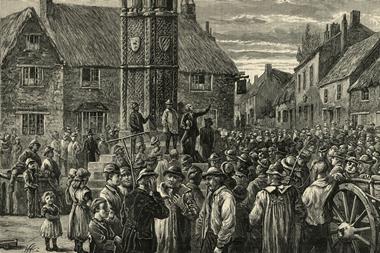Readers celebrate longevity, ponder practical purposes, and more
Regulating plant extracts
The article ‘Tea tree oil faces ban in UK and EU over reprotoxicity’ highlights a wider issue regarding assessment and hazard classification of plant extracts.
The article states that industry representatives are challenging the proposal for classification as reprotoxic Category 1B, meaning a presumed human reproductive toxicant.
As background, substances are tested or otherwise assessed according to the Reach regulation 1907/2008, and the results are used for hazard classification according to classification, labelling and packaging (CLP) regulation 1272/2008. Generally, substances are classified from the data, while mixtures are classified from the hazards of ingredients and their percentages in the mixture (the calculation method).
Mixtures cannot be tested for reproductive toxicity because of the low sensitivity of the prescribed regulatory tests. In such cases data on components should be used.
A proposed amendment to adapt the CLP regulation (EU Parliament document P9_TA(2024)0296) confirms that where data is available on constituents, the substance should be evaluated and classified as would a normal mixture, ie through the calculation method.
However, according to the proposal, there is scientific data to show that plant extracts should not be treated in the same way. Specifically, it says that constituents of plant extracts can have hazard properties that might not be expressed in the substance as a whole.
This surely plays to the public perception that plant extracts are inherently safer than general chemicals. But is there really evidence to support a different hazard classification process for plant extracts? Or is it an expedient measure to help those creating products from natural extracts, to the detriment of other chemical manufacturers?
Mel Cooke CChem MRSC
Alchemy Compliance
Long live chemists!
I was interested in Ian Shaw’s article ‘Do chemists die young?’. I graduated with a PhD (in the highly toxic boron hydrides) from Nottingham, UK, in 1963 and progressed through school teaching to teacher training to university life. I slowly moved away from the laboratory as I was deemed to be a good administrator. For instance, I sat on the Higher Education Funding Council for England’s standing committee on space management, only six of us from 110 then- universities in the 1990s.
On early retirement I progressed to be a space management consultant where space = much prized floor area. On one consultancy, I did an acceptable analysis at Dundee University where they then asked me to do the same at their Ninewells Hospital. I vividly recall a lengthy discussion with Professor Turnball. He was studying working class men in Glasgow whose life expectancy in 1995 was a mere 62. He was concerned about their poor diet, smoking and drinking. Ever since then I have watched medical concerns over diet for the poorer sections of society.
I would like to add to the conclusions of Shaw’s analysis that we chemists not only have a better lifestyle, but that we are also aware of the hazards of high carbohydrate diets, ultra processed foods, etc.
For the record I am 86 and, as far as I know, in reasonably good health. I note in the Royal Society of Chemistry’s Update reports of deaths of members that most are older than me.
Paul Roebuck CChem FRSC
Stanton-on-the-Wolds, UK
Practical problems
The article ‘The undergraduate lab practical transformation’ conveyed my thoughts back to my world in the 1960s, when I was studying for graduate membership of the Royal Institute of Chemistry by part time day release.
By that time I had joint publications to my name and I had versatile laboratory skills including modern instrumental skills and separation techniques. How odd, I thought, that titration skills and the ability to weigh precipitates were so important.
There seemed to be a great gulf between lab practices and the real world. My previous work, on an oil refinery, had involved those techniques, but I was well versed in those skills by the end of my A-level studies, taught by an elderly teacher of the Edwardian era.
Practicals have always presented problems for higher education. Clearly they are necessary, but they are fraught with problems. One of my colleagues, who routinely performed Wittig reactions for his Nobel prize winning boss John Cornforth, failed to obtain any product from such a reaction in his finals.
Practical chemistry has more potential cliff edges than our benefits system does. Good luck to those who try to rationalise things.
Michael Baldwin FRSC
Via email
Runs in the family
When I read of Theophilus Redwood, the pharmacist and analyst, my mind went back to my time at the University of New South Wales, Australia, when one of my jobs was to supervise students using the Redwood viscometer. I went online and learnt that that was devised by Thomas Boverton Redwood, son of Theophilius.
Thomas Boverton Redwood pursued a distinguished career in petroleum science. He wrote Petroleum: A Treatise, first published in 1896. He must have been one of the earliest motorists in the UK; he was driving around in a Daimler in the late 1890s.
In the Redwood viscometer the time taken for a liquid to descend a tube and exit at an orifice is measured, and the ‘Redwood viscosity’ has units of seconds. I expected my students to go a little further by giving their measurements in other units as well. That was before the time of PCs and laptops, and the students would have to consult a handbook. Those students will now be in the 55–60 age bracket.
Clifford Jones FRSC
University of Chester, UK
Chemistry World welcomes letters, which should be concise (normally fewer than 300 words) and timely. Those selected for publication are subject to editing for clarity and length. Letters should be marked ‘for publication’ and sent to chemistryworld@rsc.org
We do not routinely acknowledge letters.












No comments yet